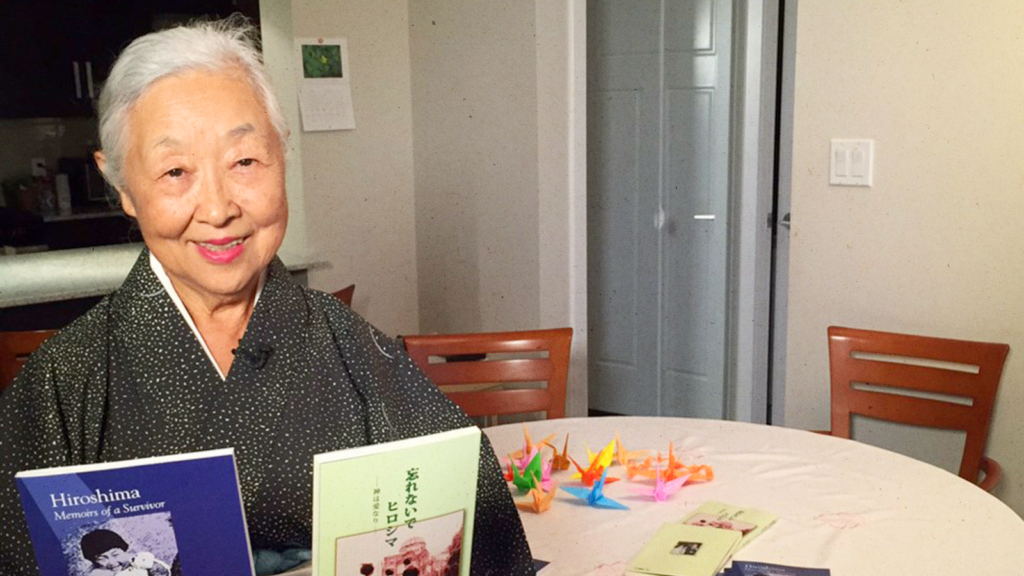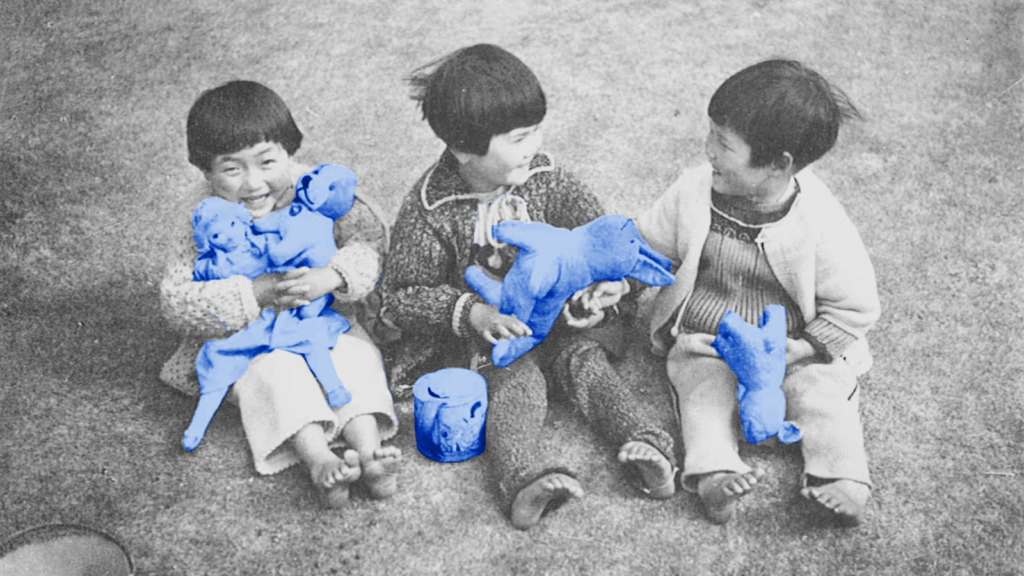On Aug. 6, 1945, an 8-year-old girl was playing with friends in her schoolyard when the world’s first atomic bomb detonated from above. Its explosion released as much energy as 16 kilotons of TNT.
An instant flash of light swallowed up the early morning daylight, leaving in its wake an inky darkness. A rush of panic overcame the schoolchildren, just two miles from ground zero in Hiroshima, Japan, as they ran for cover over broken glass and upturned chairs.
Sachi Komura Rummel believes she only survived the attack because she had been standing in the shadow of a tree.
“That temperature is almost 4,000 degrees Celsius,” Rummel, now 86 years old, tells Analyst News from her home in Vancouver, Canada. “So if you are near there, or if you had directly [been exposed to the] light, you maybe became charcoal. I was lucky that I was saved by the tree.”
That warm summer’s morning, a bomber taking off from Tinian Island on the orders of the U.S. government dropped a 9,700-pound atomic bomb on the center of her city. An estimated 80,000 people were killed instantly. Thousands more, like Rummel’s father, succumbed in the following days from their injuries. Still others, including Rummel and her family members, are living with the fallout of their exposure to radiation. Three days later, the United States dropped a second nuclear bomb on Nagasaki, killing another 80,000 or so of her countrymen.
Now, on the 78th anniversary of the bombing of Hiroshima — and as Japan is on the cusp of dumping radioactive wastewater from the Fukushima accident into the Pacific Ocean — Rummel is once again speaking up on the dangers of the nuclear threat.
That threat, anti-nuclear activists believe, is accelerating: Last year, nuclear-armed nations spent $5,000 more per minute — a total of $82.9 billion between nine countries — on nuclear weapons than they did in 2021. The United States topped the charts, per an ICAN report, spending half of that amount on its own. These countries — the U.S., China, Russia, the U.K., France, India, Israel, Pakistan and North Korea — continue to expand their nuclear arsenals, with China expected to have as many intercontinental ballistic missiles as the U.S. and Russia by the end of the decade.
In February, Russia withdrew from the New START Treaty, a nuclear arms reduction treaty with the United States, again raising alarms that a nuclear war was looming. Senior Russian officials have repeatedly warned NATO that the use of nuclear weapons is on the table in its war against Ukraine. Indeed, last month, the United Nations’s nuclear watchdog reported the presence of landmines at Ukraine’s Zaporizhzhia power station, the largest nuclear plant in Europe, now in the hands of Russia.
And on Aug. 1, in a stunning move, dozens of the world’s top medical journals published a joint editorial calling for world leaders to eliminate nuclear weapons: “The nuclear armed states must eliminate their nuclear arsenals before they eliminate us,” the journals’ editors wrote.
Against this backdrop, Rummel — who insists that she is no activist — says it’s vital that world leaders and their people heed the stories of nuclear survivors like herself.
“I want my daughter and granddaughter to tell [others] about how nuclear weapons are threatening the world and the people.”
“I want my daughter and granddaughter to tell [others] about how nuclear weapons are threatening the world and the people,” says Rummel. The scars and rashes on her body have healed in the decades since the bombing, but its effects live on in loved ones suffering from cancer. She spends her days touring schools and community centers, telling and retelling her story — the same story she first shared in her 2013 memoir, since translated from Japanese into English.
Along with artist and writer friends, she’s now working on a kamishibai project, using traditional Japanese paper theater storytelling to ensure the next generation remembers Hiroshima’s legacy even after its youngest victims pass.
“I want to give peace seeds to each of the children’s hearts, so I hope peace will grow in the future.”

The effects of Fukushima
When news recently broke that Japan was about to dump radioactive wastewater into the Pacific Ocean, activists, enraged citizens, nuclear scientists, UN-backed human rights experts and even fishermen dashed to the streets of Tokyo, placards raised, demanding a halt to the plans.
Despite a 140-page safety review from the U.N.’s International Atomic Energy Agency legitimizing the government’s approval of the plan, worries linger that contaminated water will cause devastating diseases and destroy livelihoods.
At the back of each critic’s mind is a disaster that occurred more than a decade ago. The 2011 Fukushima nuclear disaster, the worst since Chernobyl, occurred when a 9.0 magnitude earthquake devastated the country that March. The tsunami that followed the Great East Japan earthquake damaged the electrical supply lines to the Fukushima Daiichi Nuclear Power Plant and wrecked safety infrastructure. An estimated 20,000 people were killed; another 6,000 were injured.
Since then, the plant has been using 150 tons of water daily to cool down three reactors damaged in the explosion, storing it in special tanks that are posing risks to workers. With the tanks now reaching their capacity of 1.3 million cubic meters, Japan plans to release that filtered wastewater into the ocean.
But as Tatsujiro Suzuki, a nuclear engineering professor at Nagasaki University, questions: If the company that operated the plant couldn’t prevent the original disaster, can it be trusted to prevent contaminated water from leaking accidentally?
For Rummel, it was the Fukushima disaster that finally pushed her to speak up about the nuclear threat.
Despite losing her father and aunt in the Hiroshima bombing, she and her nuclear physicist brother Jiyo had long held out hope that nuclear power could still be used wisely to improve people’s quality of life. Indeed, the promise of nuclear energy has generated serious excitement and investment the world over, with governments spending millions on nuclear reactors and cutting-edge nuclear technologies to meet their clean-energy ambitions, including last month’s opening of the first new nuclear reactor in the U.S. in decades.
But for Rummel and her brother, the Fukushima accident struck a fatal blow to that idea.
“He never ever thought that this kind of accident would happen,” Rummel says, referring to the Fukushima disaster. “But it happened and he was shocked. They thought they had the perfect idea, but human beings cannot do the perfect thing.”
“They thought they could make good use of nuclear power, for peace, or use it for labor … They thought they had the perfect idea, but human beings cannot do the perfect thing.”
Rummel and her family have seen the horrors of nuclear war firsthand. But as the tragic images and testimonies emerging from the Fukushima plant brought back memories of Hiroshima, she broke an almost 70-year-long silence to warn the world that playing with nuclear power is not worth the risk.
“I think they should completely abolish [nuclear technology],” says Rummel, who wrote and translated her memoir in the wake of the disaster. “They thought they could make good use of nuclear power, for peace, or use it for labor. They had a big tragedy — that means human beings cannot control [nuclear power]. So many people were evacuated and became sick, just like in Hiroshima.”

Striving for a nuclear-free world
After the bomb fell, ripping Rummel from her idyllic childhood in Hiroshima’s suburbs, she and her classmates were rounded up and sent home. As thunder struck and black rain drizzled, she and her friend Fujita descended down a mountain, sobbing and holding hands.
Once home, as her grandmother bathed her small body, she watched Hiroshima’s city center burn and anxiously awaited the return of her beloved adopted father, Kazuo.
“He came home at midnight,” she says. “He called out, ‘I’m home.’ My mother rushed to the entrance where he had collapsed.”
Her mother dragged his irradiated body inside and placed him in bed. Days later, on Aug. 15, Japan surrendered. “My father said, ‘What a happy day today. Maybe from now on, we will have peace.’ The next day, he passed away.”
Like Kazuo, whose internal organs were charred by radiation, most victims died from burns and radiation poisoning without receiving any medical care: The blast killed more than 90% of the city’s doctors and nurses, left 42 of 45 civilian hospitals non-functional, and destroyed most of Hiroshima’s medical supplies. Some of those arriving from outside the city to provide aid died from radiation exposure.
Before-and-after photos show how the bomb, dubbed “Little Boy,” flattened the city. It razed 70% of all buildings in Hiroshima and, by the end of 1945, an estimated 140,000 people had died due to the attack. Meanwhile, most of the city’s military infrastructure was left intact. And in the years since, some experts question whether it was America’s use of nuclear weapons against Japan that brought an end to World War II.
The first-ever atomic bomb flattened Hiroshima, razing 70% of all buildings in the city. By the end of 1945, an estimated 140,000 people had died due to the attack.
Nearly eight decades have elapsed since Hiroshima burned. Today, some survivors of the Hiroshima and Nagasaki attacks are still looking for the perpetrators — the U.S. government — to apologize for the mass destruction they inflicted. It’s an apology that’s unlikely to come.
But others are not interested in mere words. Instead, many survivors are calling for a plan for total nuclear disarmament.
Rummel says she wants the world to learn a lesson from the devastation in Hiroshima, Nagasaki and Fukushima — and despairs at the failure of governments around the world in signing onto anti-nuclear agreements.
In 1968, the United States and the Soviet Union signed the Nuclear Non-Proliferation Treaty to slow the global arms race, fearing a gradual emergence of nuclear states everywhere. But today, none of the nine countries possessing such weapons have ratified the 2017 Treaty on the Prohibition of Nuclear Weapons, which would ban them from developing, testing, using, stockpiling and threatening to use them.
Rummel is quick to point out that the consequences of the next nuclear disaster could be much more dire than what her people endured. “The power completely destroyed Hiroshima,” she says. “Japan is a small, small country.” Now, the United States has more than 5,000 bombs, and nuclear weapons have also increased exponentially in power since Little Boy was dropped on her city.
Rummel doesn’t want to suffer another Hiroshima, nor see another Fukushima. She pleads for world leaders to sincerely thwart the threat of a nuclear war, for the public to renounce nuclear energy in favor of natural resources, and for the next generation to realize the risk of allowing war to escalate.
“Human beings have their own ego. Of course, they like to be number one. Arrogance sometimes makes them fight,” she says. “I hope today, young people think more deeply about how important a peaceful world is for them and their life.”

